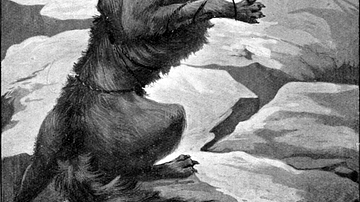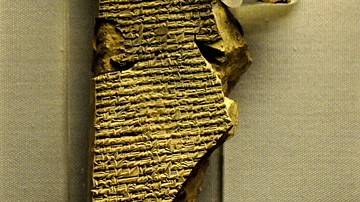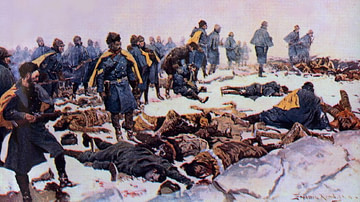Video
by Mythology Explained
published on 25 August 2021
Welcome to Mythology Explained. Today, we’re discussing Fenrir: the biggest, baddest wolf in all of Norse mythology. And there were many mighty wolves in Norse Mythology: there was Geri and Freki, Odin’s wolves; There was Skoll and Hati, the two wolves locked in a perpetual chase of the sun and the moon across the sky; but none was as ferocious or indomitable as Fenrir, who was fated to break free of his bonds and wreak havoc during Ragnarok.
Fenrir was the son of the trickster god, Loki, whose machinations and antics sowed chaos and confusion a thousand times, and of the giantess Angrboda, of whom little was known. Fenrir’s siblings were the goddess of the underworld, Hel, and the world serpent, Jormungand.
Fenrir’s early days were recounted in the myth named The Binding of Fenrir. He was raised from a pup in the halls of Asgard by the Aesir gods themselves. But Unlike Loki’s other children, the gods deemed Fenrir too fearsome and destructive to let loose. The world serpent was cast into the oceans of midgard, where it eventually grew to such an immense size that it encircled the earth, and Hel was sent faraway to rule the realm of Hel, where the gods would seldom come into contact with her. However, no such half-measure would suffice for Fenrir.
He was kept close and grew at an astonishing rate. Of all the gods, only intrepid Tyr, a war god associated with law and justice, dared approach the wolf to feed it. After a time, it became clear that Fenrir’s size and power were becoming completely unmanageable, so allowing him to roam free around Asgard could no longer continue. The gods decided that Fenrir would have to be incapacitated in some way, so they imprisoned him by chaining him to a rock. The gods attempted to fetter him with multiple chains, each one stronger than the one before. They were able to gain the wolf’s confidence by telling him that the chains were a contest to test his strength, but eventually it became clear that no chain they possessed was strong enough to withstand the wolf’s strength.
To remedy this issue, the gods turned to the dwarves, asking them to craft the strongest chain ever made. The chain they ended up making was wrought from the sound of a cat’s footsteps, the beard of a woman, the roots of mountains, the breath of a fish, and the spittle of a bird. This new chain was different from the others. To look at it, you wouldn’t guess it to be unbreakable, having a slight appearance that beguiled its strength. It was slim and supple and more so resembled a ribbon than a chain. Because this restraint was so different than the ones that came before, it aroused the wolf’s suspicions. Fenrir agreed to be chained again but only if one of the gods placed a hand in his mouth. Of all the gods, only Tyr was fearless enough to place his hand in the wolf’s mouth; and as expected, when the wolf could not break the chain with his thrashing, and when the gods would not release him, the wolf exacted his price by biting off Tyr’s hand, taking his petty revenge. Once the wolf was chained, they transported him to an isolated place and wedged a sword in his mouth to keep his jaws from snapping. Having his mouth propped open caused drool to constantly stream out, creating the river Van, which translated to expectation, a foreboding name. And in this sorry state the wolf was kept until Ragnarok.
When Ragnarok starts and all bonds are broken, supposedly Fenrir will break loose to be a scourge upon the land. His bottom jaw will scrape along the earth; his upper jaw will press up against the ceiling of the sky; and everything in his path will be devoured. Following this, Fenrir and Odin will meet in combat. It is said that Fenrir will swallow Odin, killing him, but that the victory will be fleeting, for soon after, Odin’s son, Vioarr, avenges his father. Vioarr will be able to succeed where his father failed by donning a magical boot: since time immemorial, every scrap of leather left over by cobblers and boot makers was salvaged and used to craft an indestructible boot. Vioarr will use the boot to press down the wolf’s lower jaw with his leg, giving him the purchase he’ll need to rip the wolf’s head apart.
And that’s it for this video! If you enjoy the content please LIKE the video and SUBSCRIBE to the channel.
Until next time
Remember
If aware that another is wicked, say so:
Make no truce or treaty with foes.
License & Copyright
Original video by Mythology Explained. Embedded by Joshua J. Mark, published on 25 August 2021. Please check the original source(s) for copyright information. Please note that content linked from this page may have different licensing terms.
The video and its description text are provided by Youtube. This website claims no authorship of this content; we are republishing it for educational purposes.





